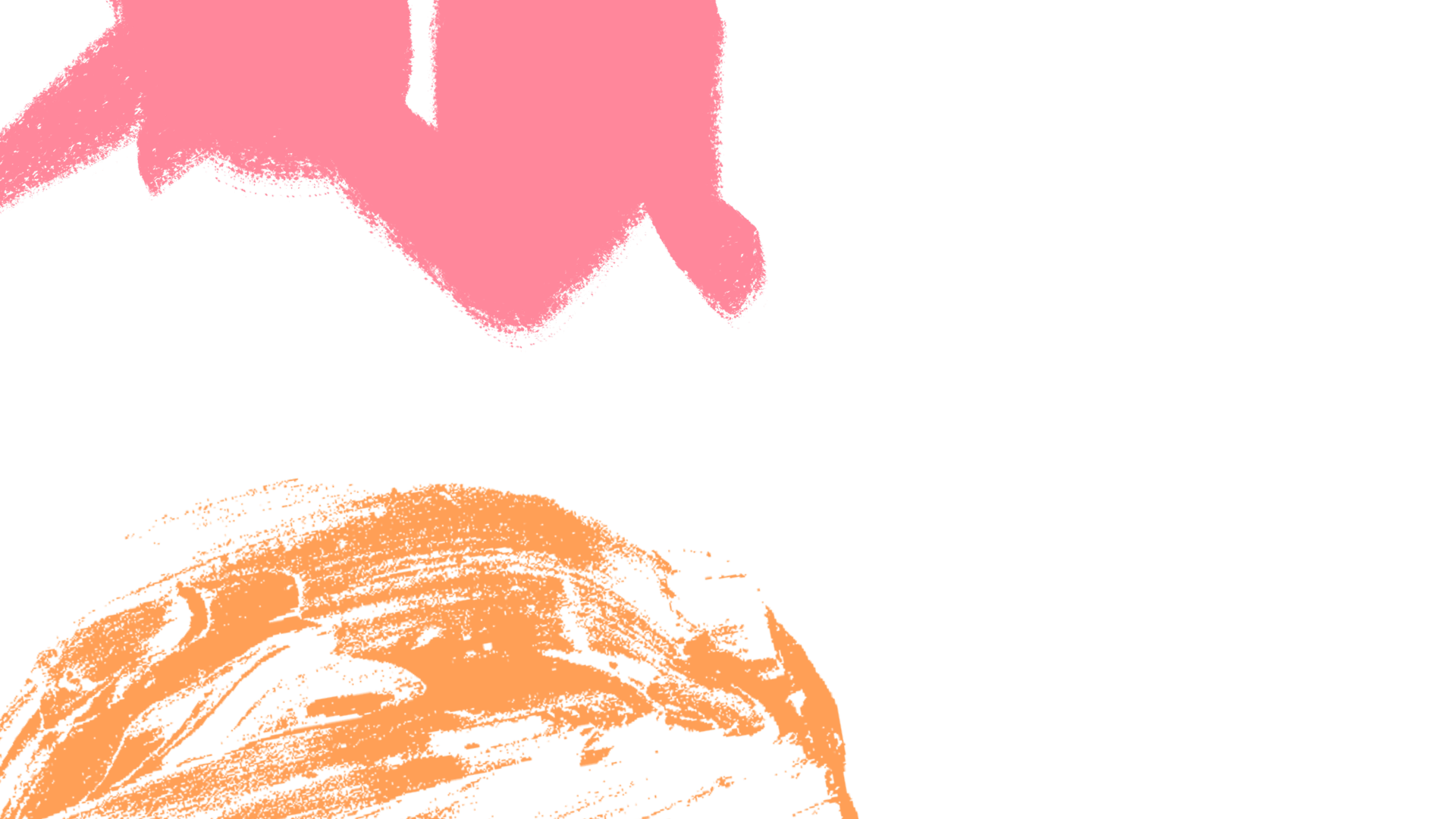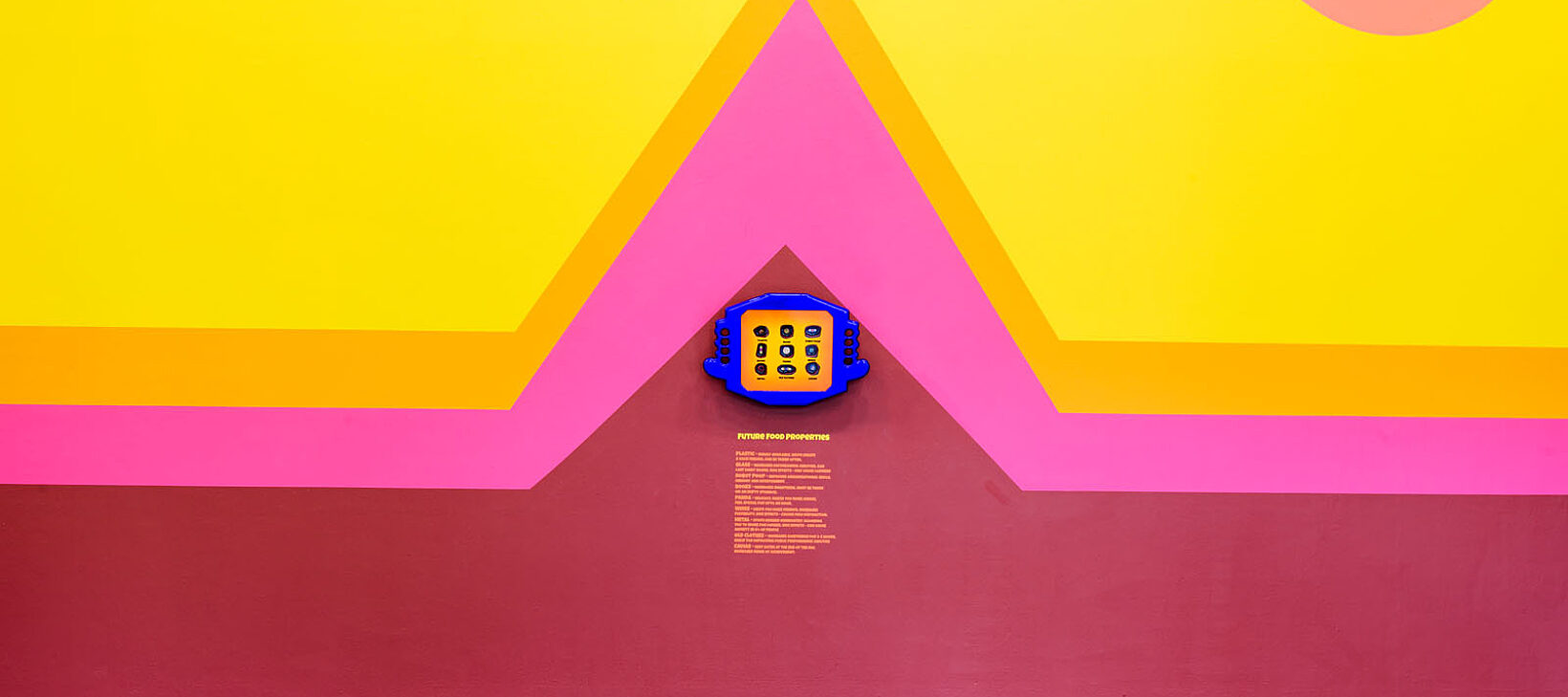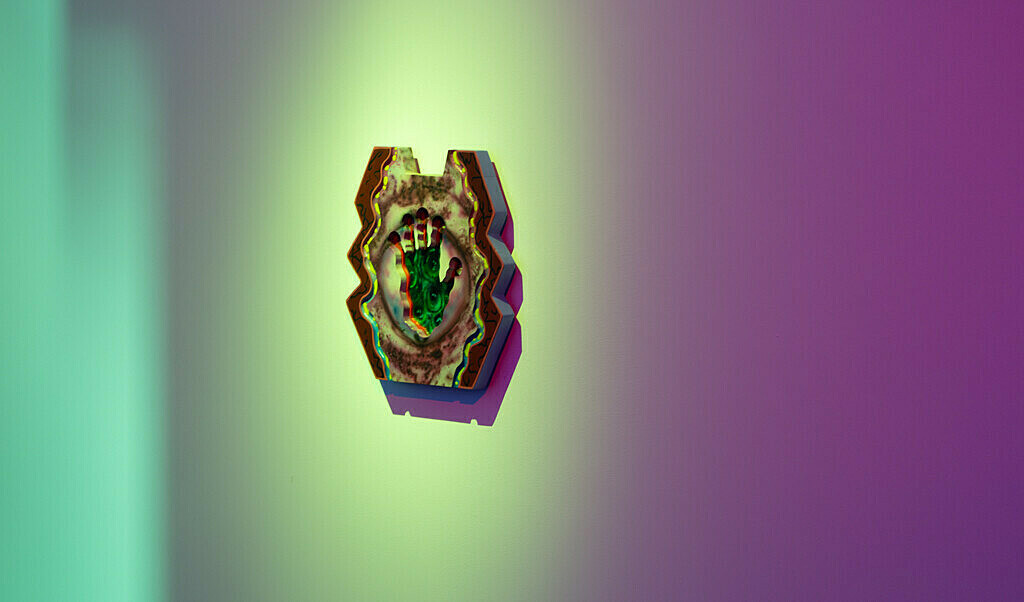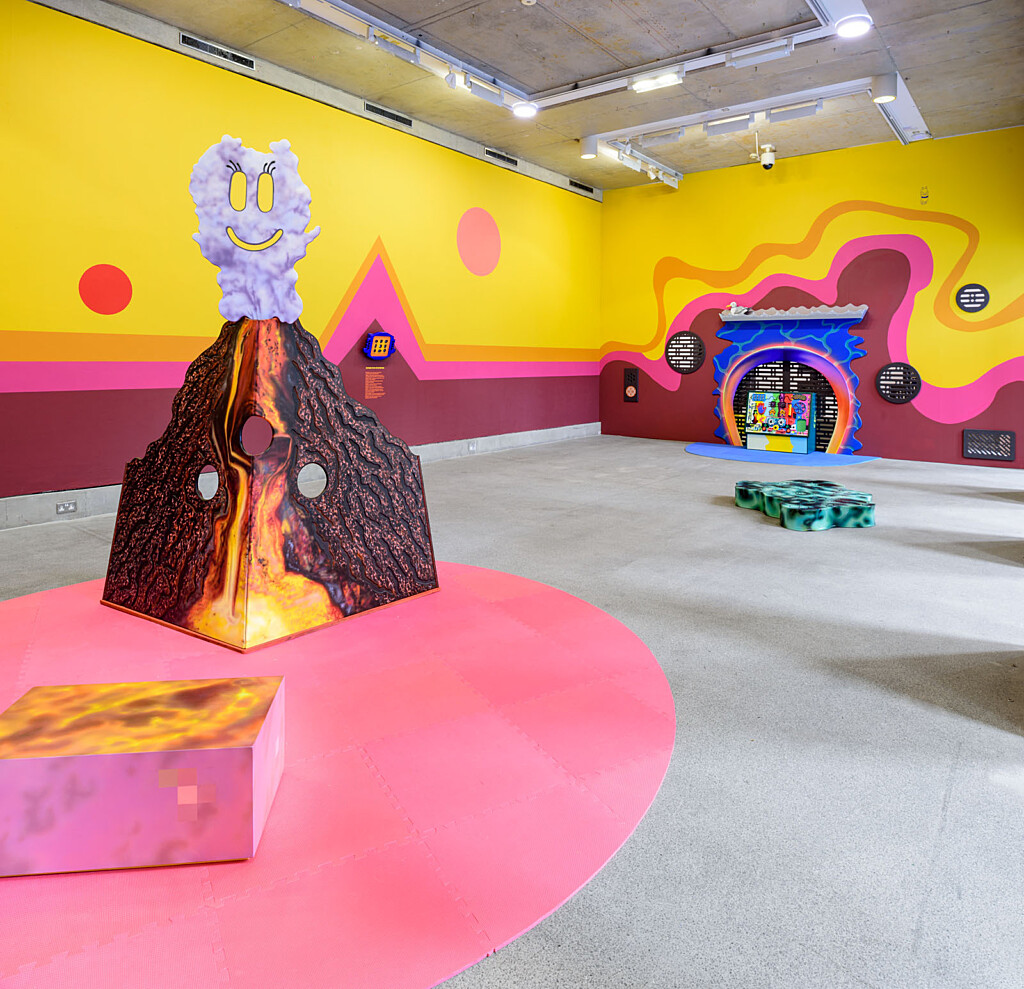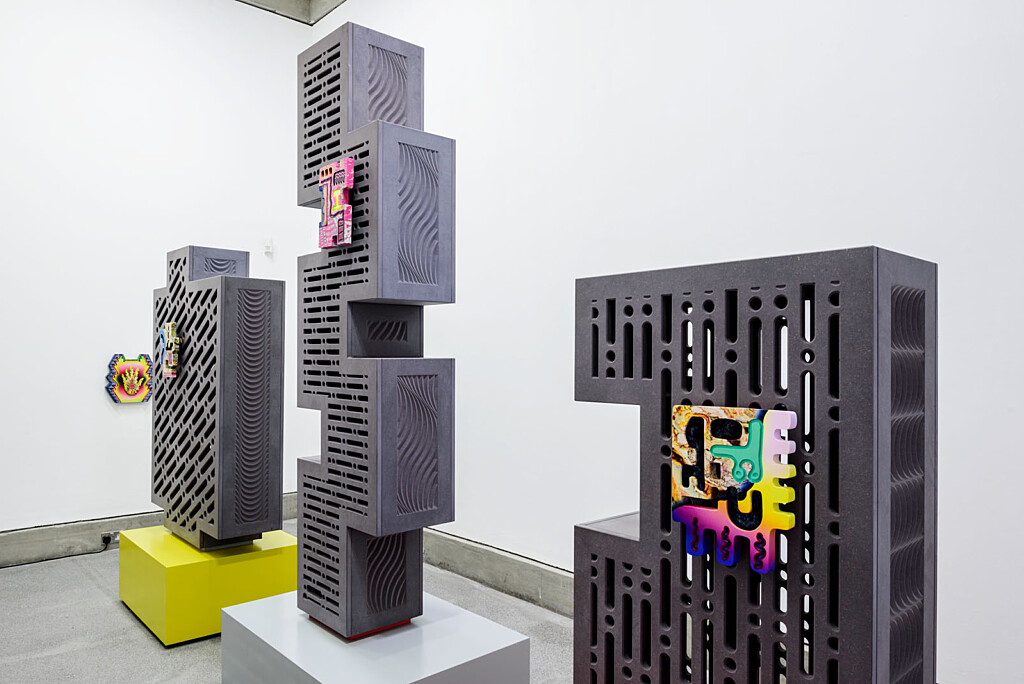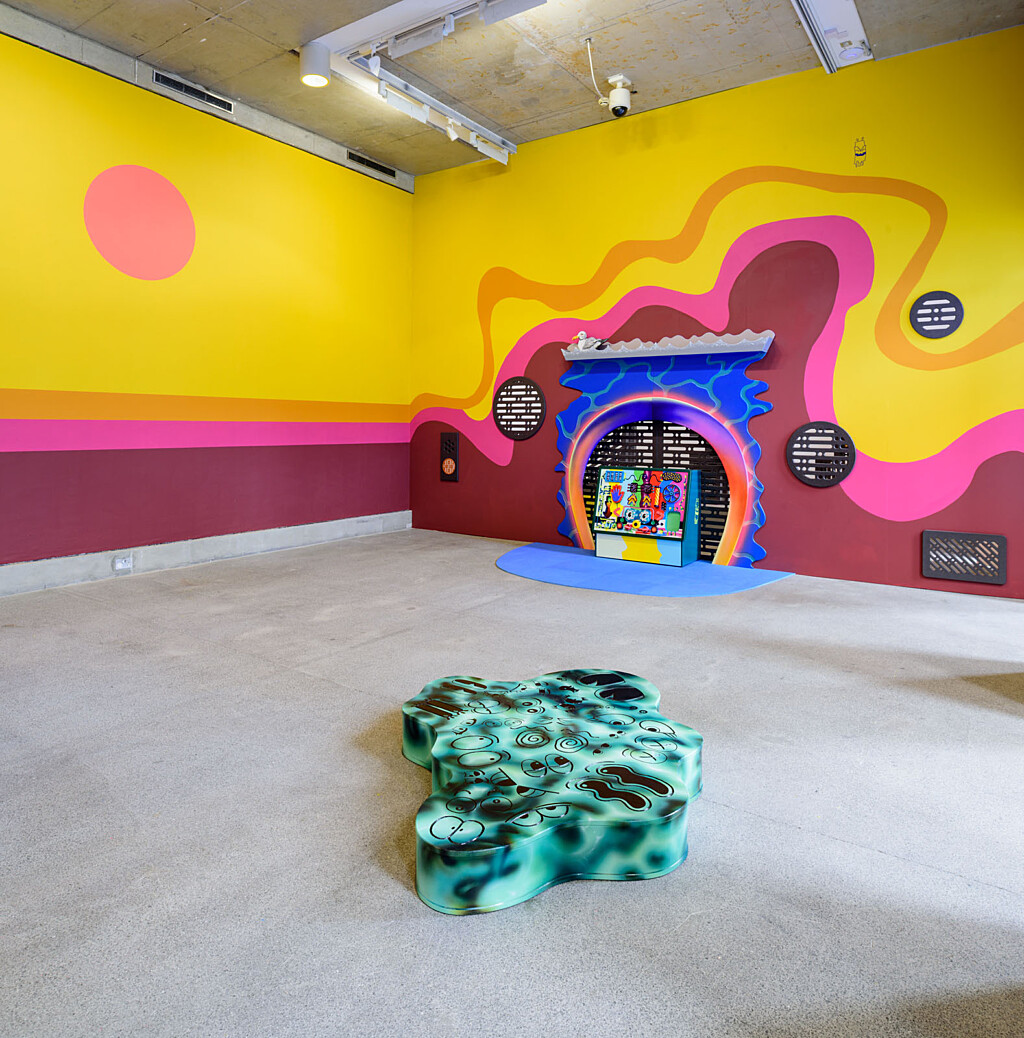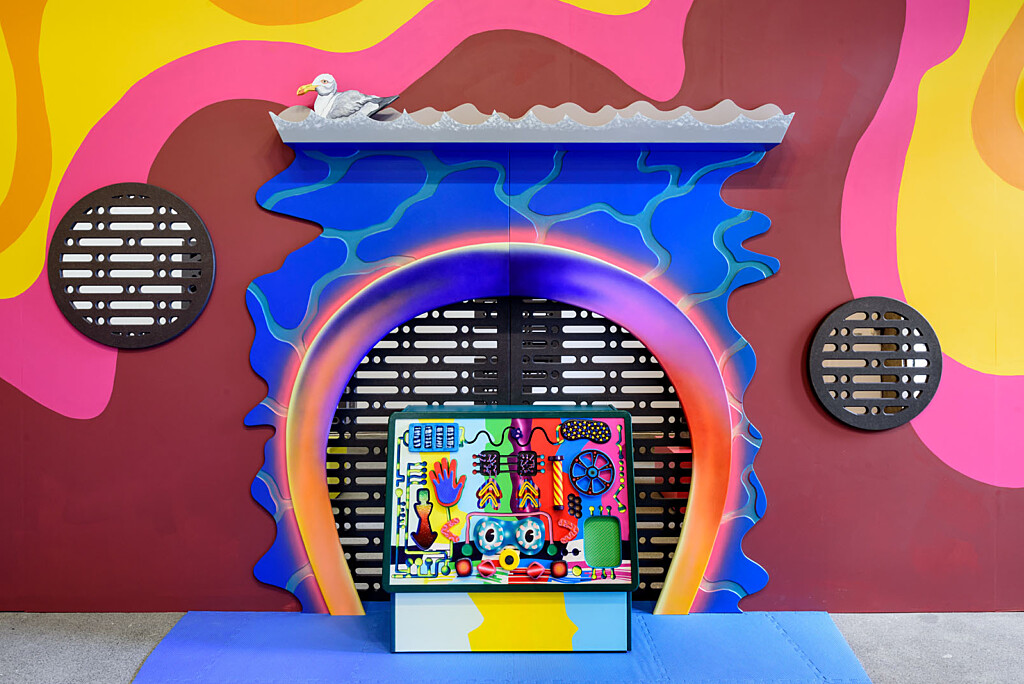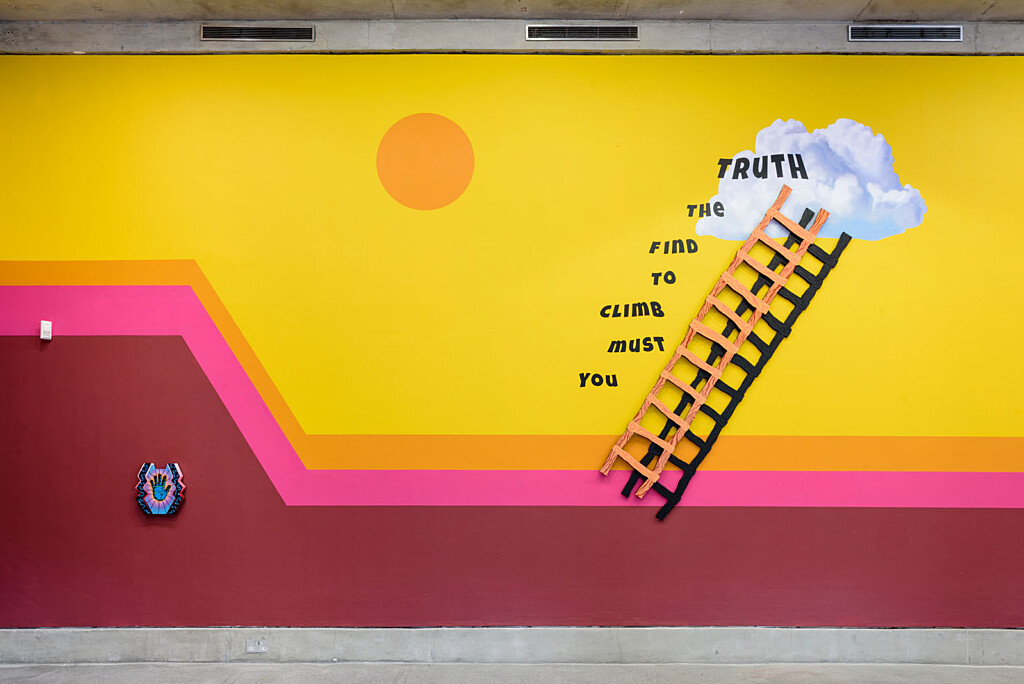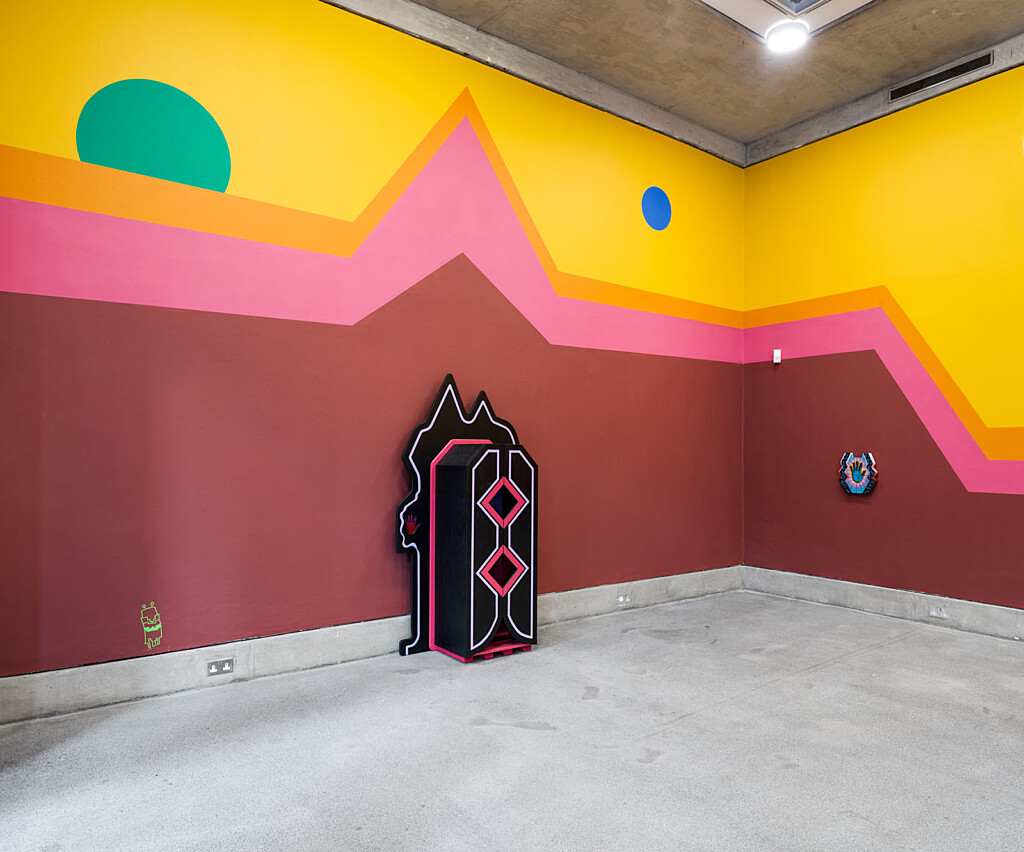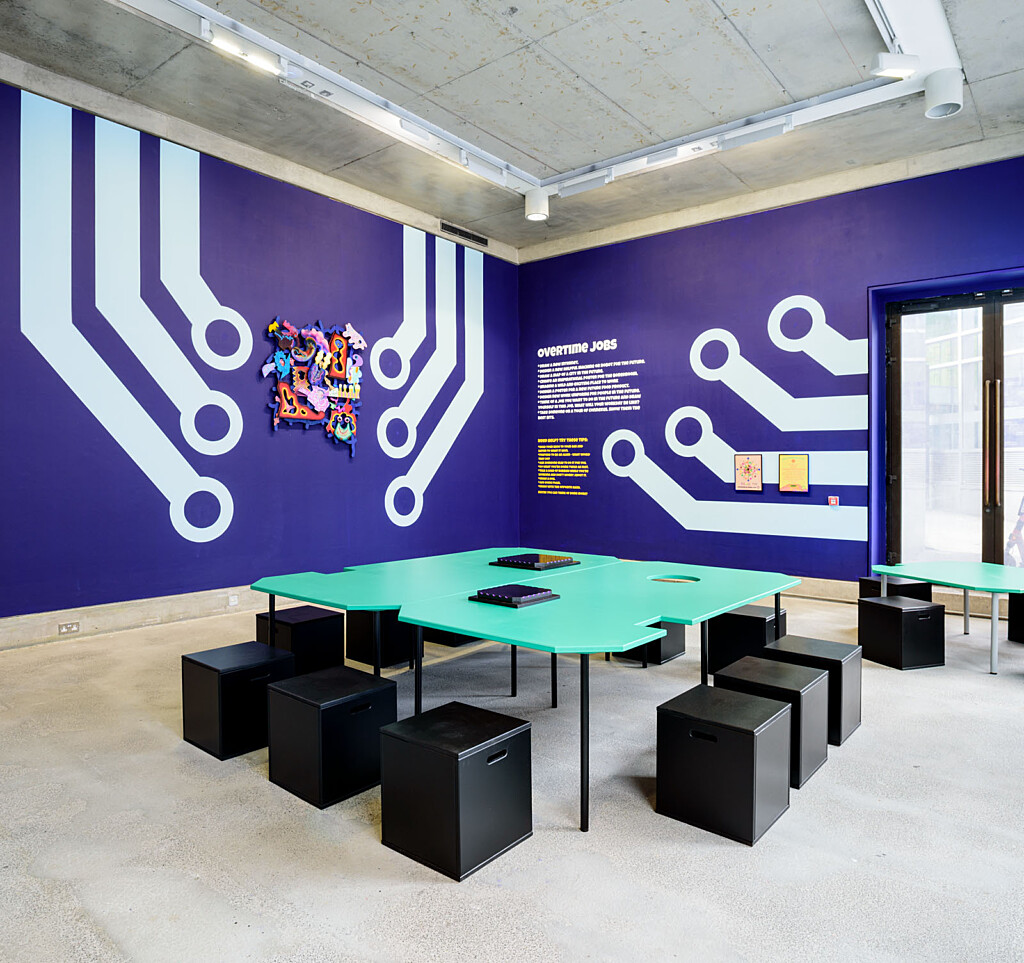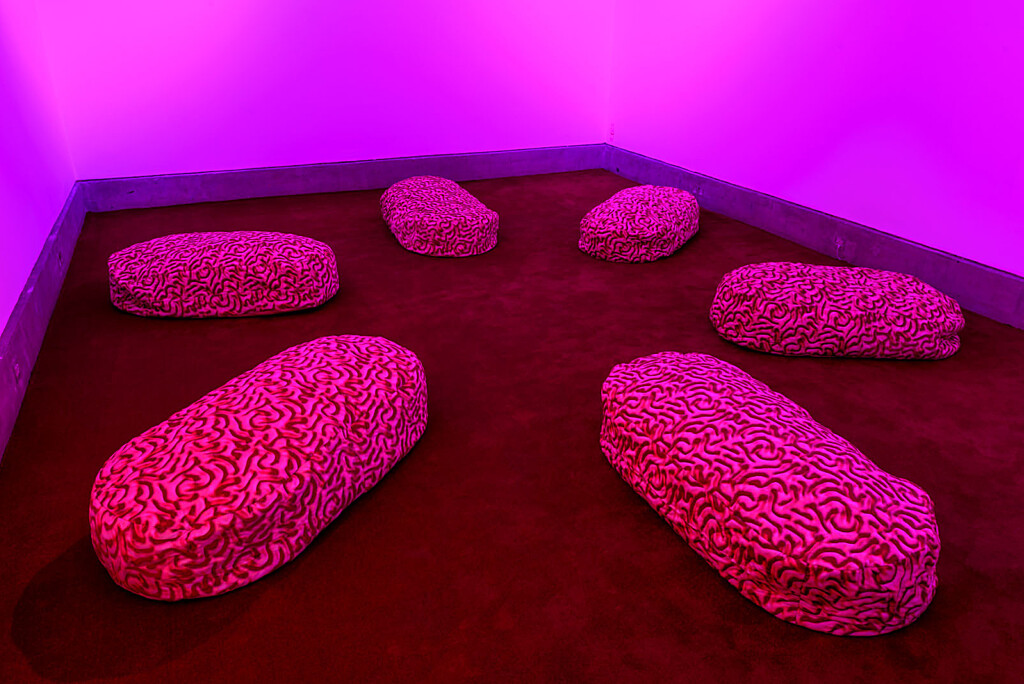After a long, slow journey meandering across the country, I arrive at the headquarters of Connexus to discern how this futurity-device came into existence.
This is how it began.
START: Find a hand scanner and scan in. NOW GO TO 1 >>
Connexus is many things. It is mythopoesis(1). It is a fictional creative corporation. It is speculative research exploring the world of work and how this might be transformed in the future. It is trying to make sense of the different roles people play in developing ideas together, the messy processes of communication and collaboration, and how these often (mis)translate into things. It is the result of artist duo Roxy Topia and Paddy Gould working with children from Out of the Blue(2). It is an artwork presented as an exhibition Let Your Ideas Come Back As Children at The Bluecoat. It is the ongoing bending and re-configuring of these (and other) ideas in the minds of people that encounter them.
In exhibition form, Connexus could be seen as a distillation of all these things. Extracted meaning, or sculptural form emerging out of the various conversations, observations, exercises and expectations that make up the process of layered collaboration. It is physically manifest as four discrete rooms –Meditation, Creative Ops, Server, Boredroom – and the various workstations, or activities that potentially make up your workday. A printed map with navigational instructions turns the experience of Connexus into a physically embodied Choose Your Own Adventure, where your actions where your actions in one place, or how you perform a particular task, determines where you go next.
Did you come up with a plan? YES >> GO TO 7 / NO >> GO TO 8
Each workstation is a carefully crafted sculpture or additive relief. The painted surfaces are reminiscent of Surrealist automatic drawing, but with the brightness turned up to eleven. Garish colours pop, and the objects mash-up this early 20th century drawing technique with the high-sheen aesthetics of contemporary sci-fi, computer games and car body repairs. Each component part encourages some form of interaction, they can be touched, listened to, played with, or more broadly used to do the good work of Connexus. Whether it is the Happy Volcano on Mars that you inhabit – shoving your face and arms through cut-out holes, like a seaside photo stand-in – to interview new workers required to fill the labour shortage on Mars, or the more cathartic Overwhelmed Blob of Emotions that becomes a soapbox for an outpouring, or even purging, of our bottled-up-feelings.
Whilst many elements of the exhibition display a crisp, defined or even polished veneer, smooth to the touch, I am drawn to what I would (appreciatively) describe as its frayed edges. Places where there is an uncertain or unsteady quality, where the threads unravel – revealing the possibility of something else, within, beneath, or behind, what is visibly present. A back-story perhaps. Certain narrative threads reach out in a particular direction (towards an actual process), but others head off in many other directions (towards simultaneously possible iterations of Connexus, past, present and future). To purposefully mix my metaphors, these threads are like the many tentacles that reach out from the body of the exhibition, tenta-tively feeling for meaning, one not yet fixed or known.
This is how I feel now (with my tentacles). Drawn to extrapolation, or a tangential interlude.
SINK THE PIRATE
(Hard day at the office?) It’s like everything that could go wrong, has. Luckily my co-workers are fully IN-SYNC; tuned into my unusually heightened stress levels. It’s blatantly obvious to everyone around me in the Content Department that something’s not quite right. No wonder – my HPA axis is all out of kilter, my body all revved up, and my cortisol receptors firing! I need to decompress. (But don’t fret) I’m lucky enough to work for Connexus, and today, over our lunch break, I am the designated Pirate.
I have seen this happen before, but never from this perspective. My fellow Content Creators have their specific roles to play. I hear swivel chair wheels approaching from the other side of the room. I feel hands gripping my shoulders, gently but firmly pushing me downwards (… the synthetic leather squeaks as my backside presses against the well-used seat pan). I know what’s coming next, but somehow, it’s out-of-body experience – literally ‘seeing (my)self’. My disembodied eyes focus in on the Pirate’s hat lowered onto my head (as though on strings) … and I notice the chair base bobbing on the surface of the (recently materialised) water bel … Ouch! I am abruptly jolted back into my body. The skipping rope tightens around me, pulling three red bricks into my stomach, now heavily laden, forcing me against the lumbar support system.
The scene is set. I know what I need to do. I’ve read the instructions on the Blueprint many times. I even keep a picture of it on my phone: “Stay still … very still … or the bricks will fall, and you will go in the water.” I really, really don’t want to end up there. (Stop thinking about it that way) This is an opportunity after all, my opportunity to apply the brake and dampen the stress response. Deep abdominal breathing. In, out. In, out. Focus on each body part individually. Each muscle tensed and released, becoming progressively warm, heavy, and relaxed. Then, pause … and use this gentle unwinding to focus … and visualise a tranquil scene … my chair-cum-raft washes against the sandy shore of a tropical island, and young green coconuts fall conveniently from the nearby trees – each nut ready-prepared with a protruding paper straw. As I slurp up the sweet nutty liquid inside, the spell is broken … and a somewhat grating announcement comes over the tannoy …
“This is company care. This is Connexus care.”
This is how I remember (or conjecture) it anyway.
To be more straightforward, Sink the Pirate is a self-described ‘stress busting game’ – one designed by the children. As it was recounted to me, the game was physically devised through play (which I did not witness), but see it here re-presented as one of many ‘Blueprints’ in the exhibition, served up as inspiration to “think about the future!” This might be what is described as the “macabre”(4) or dark side of the children’s imagination becoming manifest, but it is important not to shut down this possibility. The collaboration should allow space for the children to explore and express themselves without fear of overly narrow, prescribed or normative (adult) judgement. Something that Roxy and Paddy described to me as “wanting to let them be and see who they were in the moment.” An approach that is befitting of collaborating with anyone.
Our identities are not fixed; collaborations enable different versions of ourselves to be performed. Even if our individual roles are defined, we do not ‘stay put’, we are constantly making adjustments, and in response other parts of the collaboration need to make further adjustments, and so on, ad infinitum. This play creates space for individuals to take on new roles, test what is expected, and explore what is (im)possible.
In Commonwealth (2009), Michael Hardt and Antonio Negri claim that: “The path of joy is constantly to open new possibilities, to expand our field of imagination, our abilities to feel and be affected, our capacities for action and passion.” Their analysis of Spinozan ‘joy’ and the correspondence they draw between our power to affect and our power to be affected, is something to hold onto when thinking about how we work with others, whoever they are.
YOU ARE AN IMPORTANT COG IN A VALUABLE MACHINE
This is how it really began, or to put it another way, let’s talk about the cogs of collaboration.
Adam and Betty from The Bluecoat reached out to Roxy and Paddy and invited them to make an exhibition collaborating with children. This presented the artists with a degree of uncertainty: they had not worked with children before, and don’t have children of their own (they could therefore be seen to lack specific experience). To overcome this hesitation, they first collaborated with their niece – a particular type of expert or willing consultant – helping to test initial ideas, fill the gaps in their own experience, and explore what might be possible (their niece is listed on the Connexus diagram, appropriately, as a Beta Tester). Collaboration is not new to Roxy and Paddy. As an artist duo they are constantly collaborating with each other, and more sporadically with others, including writer and musician Cormac Gould (who was involved creatively in this exhibition as well as on past projects), and with friends, artists and writers through their independent press Pink Sands Studio. The sandbox approach (with their niece as play tester) made it clear that they could approach the project organically, similarly to how they might work with other people, focusing in on shared interests.
Feel better now? YES >> GO TO 6 / NO >> GO TO 4
In early 2024, Roxy and Paddy hosted several workshops with children from Out of the Blue.
Informed by different forms of work/place, particularly those of tech companies, they began by asking the children to think about how they would improve the lives of adults working in a creative corporation in the future. Initial questions turned into exercises that expanded the scope of imagination. Asking the children to draw the internet, make advertisements for future food products, put their hands in bags of jelly, listen to Raymond Scott and Jim Henson’s Limbo: The Organised Mind and then visually map out ‘what a mind is’. All the time, talking with the children, listening to everything they were saying, recording observations of their interactions with each other, as well as looking at (and working with) their creative responses.
The performative fiction of Connexus as a creative corporation lends the workshopping process a particular vibe: maximalist data collection as experimental focus group (although perhaps not as instrumental as it sounds, more of a purposeful overidentification with such corporate structures). To be more playful and put it another way: this fiction provides a stage set of sorts, a space of uncertainty where ideas and things can emerge through performative roleplay, leading to a concrete decision to ‘gamify’ the exhibition (as Roxy and Paddy described it).
Gradually, gropingly, the shape of the project and the exhibition emerges. It is not about creating a facsimile of something that took place in the workshops (a word-for-word translation of something that was said). The collaboration ultimately takes place on multiple levels, within the formulation of individual ideas and broader concepts, as well as the physical realisation of the work itself. It is a careful balancing act between roles and expectations – with different people involved in different ways, and at different times. Working with the children's contributions, there are layers of problem-solving and extrapolation required, involving back and forth between the artists, as well as with the technicians and The Bluecoat more broadly as an institution (with its various departments). Collaborative ideas are not necessarily linear or straightforward to describe.
This is where I start to daydream … (going back to this earlier idea) of the exhibition as a distillation of all the cumulative inputs. Diagrammatically it is an inverted cone. The inputs that can be seen entering the base of the cone are the possible dimensions of the project, actualised at its apex (on the physical plane) in exhibition-form. Not everything that goes into the cones comes out the other side. But, stepping back, I see that there is a double cone joined at the apex (either side of the physical plane), which presents the possibility of other (virtual) dimensions of the project that remain unexplored or unactualised… at least not yet, not today, or not in my mind… so …
FINISH: Find a hand scanner and scan out. See you tomorrow!
References
1 - Mythopoesis is proposed by David Burrows and Simon O’Sullivan in Fictioning (2019) as “productive of worlds, people and communities to come, often drawing upon residual and emergent cultures”.
2 - Out of the Blue is the Bluecoat’s after school art club for children aged 8-11. Since 2014, Out of the Blue has been
delivered weekly in a variety of schools across the city, including those in Norris Green and Anfield.
3 - Choose Your Own Adventure was a series of children's interactive books popular through the 1980s and early 1990s where each story is written from a second-person point of view, with the reader taking on the role of the protagonist and making choices that determine the main character's actions and narrative ending.
4 - The exhibition handout describes that the “children’s ideas of what the future holds ranges from optimistic idealism to macabre realisations."
Downloads
Download the full PDF here
About Niki Russell
Niki Russell is an artist, curator, and currently Director of Primary in Nottingham.
Find out more about Niki's work:
Instagram: @thisisnikirussell
About the Exhibition
Let Your Ideas Come Back As Children was a thought provoking family-friendly exhibition from Merseyside based artists Roxy Topia and Paddy Gould with Cormac Gould, created in collaboration with children aged 8-11 from Out of the Blue, the Bluecoat’s after school art club.
